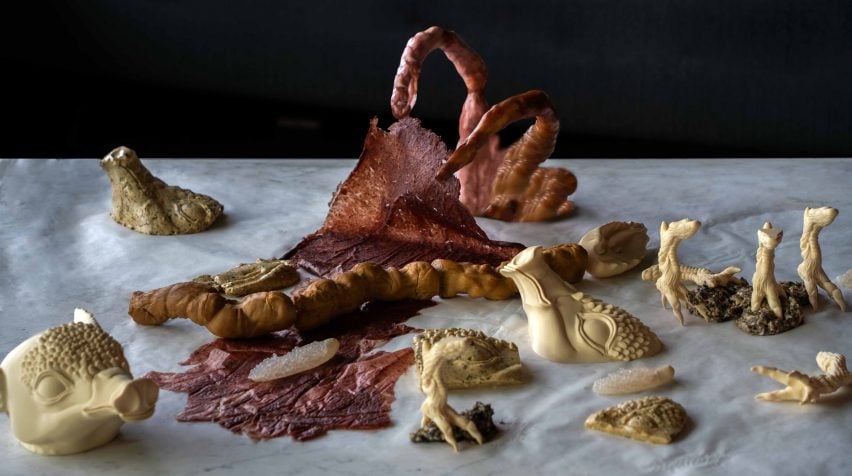Taiwanese designer Hsin Min Chan served up the head, skin and tail of an imaginary creature – all made from vegetarian food waste – at a dinner event during Dutch Design Week.
The project, Exotic as a Species, saw Chan create an illusionary version of nose-to-tail eating.
The Netherlands-based designer wanted to show the value of food products that are typically not made use of in Western cuisine, so often go to waste.
In Asian cuisines, it is common to cook every part of an animal. Chan decided to take the same approach with her vegetarian ingredients, turning them into fake animal parts.
She designed a fictional exotic creature combining elements of a pig, deer, duck, fish and chicken, which formed the starting point for five edible substances.
These included a tail made from compressed tofu skin and a bone marrow made from sago, a former food staple that is rarely used in European cuisine today, combined with bamboo mushrooms.
The animal head was made of kombu miso butter, while a semi-transparent skin was created from a blend of apple pulp.
The fifth element, described by Chan as "feet sauce", was a stuffing-like substance made from wood ear fungus, which is native to Europe but rarely eaten outside of Asia.
Diners were invited to lick the feet sauce off cutlery shaped like chicken's feet.
"Exotic as a Species emerged from my ongoing research into how the 'exotic gaze' can shape and sometimes distort non-Western narratives," Chan told Dezeen.
She said the aim was to challenge preconceptions, "examining food from a perspective that resists Western-centric assumptions about value and waste".
The designer came up with the idea after exploring historic ties between her native Taiwan and the Netherlands, where she has been based since moving to study at Design Academy Eindhoven.
In the 17th century, during the Dutch colonisation of Taiwan, the Dutch East India Company or Vereenigde Oostindische Compagnie (VOC) exported a range of goods from east and southeast Asia, including rare plants and animals.
The "colonial curiosity" towards this produce led Chan to design her fictional creature.
"By merging historical and speculative elements, this creature highlights the contrast between the Western fascination with the exotic and non-Western practices that value every edible part," she said.
"Using food as a tangible, sensory medium, this project invites people to experience food – and, by extension, culture – from a more inclusive, less familiar perspective, sparking curiosity and new ways of seeing."
Exotic as a Species formed part of Narrative Native Dining, a dining experience featuring a series of food-based design projects.
Curated by Chan and cultural venue NOR, and organised by Maarten Lockefeer of Keukenconfessies, the event explored how different cultures have influenced Dutch cuisine.
Also featured were Meals from a Salt-Burnt Ground, which explored the impact of salt salinisation on crop growth, and A Century of Flowing Peanuts, which looked at how Chinese boatmen peddled peanut cookies in Rotterdam harbour.
This year's Dutch Design Week also featured cartoonish furniture and a six-tiered pyramid wrapped in colourful flags.
Dutch Design Week 2024 took place in Eindhoven from 19 to 27 October. See Dezeen Events Guide for an up-to-date list of architecture and design events taking place around the world.
The photography is by Ernst Zomer, Jian Da Huang and Yu-Tzu Huang.

